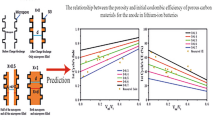Abstract
A simple charge-porosity diagram is presented for the rapid estimation of charge capacity in battery electrodes. Porosity changes reflect differences in mole volumes of the reactants and reaction products. Each system has a specific sensitivity to porosity changes. This diagram can be a useful tool for the assessment of mass and current transport performance of electrodes that give insoluble reaction products. Alkaline Cd, Zn and Fe electrolytes are compared.
Similar content being viewed by others
Abbreviations
- c :
-
electrolyte concentration mol cm−3
- F :
-
the Faraday equivalent, As per mol equiv
- I :
-
current, A
- M :
-
mole weight
- ¯Q :
-
normalized charge density, dimensionless
- R :
-
reactant balance ratio between matrix and electrolyte phases
- t :
-
time, s
- V :
-
electrode volume, cm3
- ¯V :
-
partial mole-volumes, cm3 mol−1
- (s):
-
solid phase
- (aq):
-
aqueous phase
- ε :
-
porosity
- ρ :
-
density, g cm−3
- ν :
-
stoichiometric coefficients
- i:
-
species i
Author information
Authors and Affiliations
Rights and permissions
About this article
Cite this article
Selånger, P. Analysis of porous alkaline Cd-electrodes. III. The application of charge porosity diagrams in electrode design. J Appl Electrochem 4, 263–266 (1974). https://doi.org/10.1007/BF01637236
Received:
Issue Date:
DOI: https://doi.org/10.1007/BF01637236




